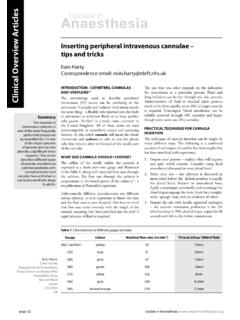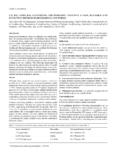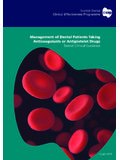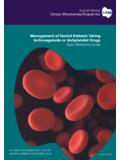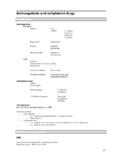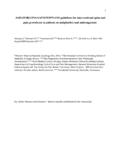Transcription of Perioperative Management of Cardiovascular Drugs …
1 Perioperative Management of Cardiovascular Drugs Dave Pappin and Vanessa Helliwell, Exeter, UK. Email: It is estimated that by 2010 Cardiovascular disease The most commonly prescribed Cardiovascular Drugs will be the leading cause of death worldwide. In or drug categories are: some countries more than 1 in 4 people suffer from some form of Cardiovascular disease. Many surgical Adrenoceptor antagonists patients take Cardiovascular medications and the Nitrates Perioperative Management of these medications ACE inhibitors poses particular challenges for the anaesthetist. Decisions must be made based on a careful risk- Anti-arrhythmics benefit analysis for each patient. The risk of stopping Angiotensin II receptor antagonists some Drugs is often greater than the risk of continuing Antiplatelet Drugs them during surgery, but surgery itself may alter the Calcium channel blockers need for continued therapy for certain conditions.
2 This article offers a guide to the medications you may Anticoagulants encounter and provides advice on how they may be Diuretics used in the Perioperative period. Lipid-lowering Drugs Adrenoceptor antagonists These agents work by blocking the action of catecholamines at 1 or 1 adrenergic receptors, or both. 1-adrenoceptor antagonists (Betablockers) the -olols'. Classification Cardioselective - block 1 receptors preferentially (eg. atenolol, metoprolol, esmolol, nebivolol). Non-cardioselective - block 1 and 2 receptors (eg. propanolol, sotalol). Dual action at 1 and 1 receptors (labetolol, carvedilol). Indications Angina, post-myocardial infarction (MI), hypertension, supraventricular arrhythmias (especially those associated with increased catecholamine levels).
3 Mode of action Antagonist at 1 receptors causing reduction in heart rate and force of myocardial contraction, thereby decreasing workload and increasing coronary perfusion time. Improve ischaemia by restoring the myocyte's oxygen supply demand balance Action on 1 receptors in renal juxtaglomerular cells leads to decreased circulating levels of renin and angiotensin II, resulting in lowering of blood pressure As class II antiarrhythmics reduce sinoatrial node automaticity, prolong ventricular conduction and extend the refractory period at the atrioventricular node Side effects Bradycardia, cold peripheries, CNS effects if lipid soluble drug (metoprolol, propanolol), depression, lethargy, bronchospasm Perioperative Management Most centres advocate continuing -blockers throughout the Perioperative period, especially in those at high risk of ischaemic events.
4 Studies have found that 1 blockers reduce Perioperative ischaemia in patients with underlying Cardiovascular disease. There is some evidence that -blockers reduce the risk of Perioperative myocardial infarction and death. 39. 1-adrenoceptor antagonists eg. indoramin and the -azosins' doxazosin, prazosin, terazosin Indications Hypertension, congestive heart failure, Raynaud's syndrome, benign prostatic hypertrophy Mode of action Prevents 1 - mediated vaso-constriction, reduces systemic vascular resistance and blood pressure Side effects Nausea, postural hypotension, dizziness, headache Perioperative Management Continue throughout Perioperative period No intravenous formulations exist, so recommence once oral intake re-established eg.
5 The -prils' captopril, lisinopril, enalapril, Angiotensin Converting Enzyme Inhibitors (ACEi). perindopril, ramipril, cilazapril, fosinopril Indications Hypertension, left ventricular dysfunction, post-MI, delaying progression of proteinuria and renal impairment in diabetes Mode of action Angiotensin converting enzyme (ACE) inhibition leads to decreased synthesis of angiotensin II. Angiotensin II normally causes peripheral vasoconstriction and stimulates aldosterone release, resulting in retention of Na+ and water, and excretion of K+. Lowering angiotensin II levels results in reduced vascular resistance and reduced fluid retention. Ventricular ejection and cardiac function are therefore improved. Remodelling of the ventricular muscle is also facilitated Side effects Postural hypotension, dry cough (bradykinin is usually broken down by ACE and so levels rise), rash, angioedema (causing swollen tongue).
6 Perioperative Management Often contributes to exaggerated of hypotension on induction and during maintenance of anaesthesia, particularly in presence of hypovolaemia Many anaesthetists omit on the morning of surgery particularly if performing neuroaxial blockade (epidural or spinal). Some centres recommend stopping ACEi on morning of surgery if part of therapy for LV dysfunction, but continue it if the indication is hypertension Angiotensin II receptor antagonists (ARA's) eg. the -sartans' - losartan, candesartan, irbesartan, valsartan Indications Hypertension Mode of action Specific angiotensin II type-1 receptor (AT 1) blocker Similar Cardiovascular actions to ACE inhibitors Bradykinin-mediated side effects (eg. dry cough) are avoided since ACE is still active Side effects Postural hypotension Perioperative Management As for ACEi 40.
7 Calcium channel blockers Classification I Phenylacylamines (eg. verapamil). II Dihydropyridines (eg. the -dipines' - nifedipine, amlodipine). III Benzothiazepines (eg. diltiazem). Indications Hypertension, angina, dysrhythmias Mode of action All act on L-type calcium channels present throughout the Cardiovascular system Different classes act on the myocardium, cardiac conduction systems and vascular smooth muscle to varying degrees: Dihydropyridines mainly cause peripheral vasodilation Verapamil and diltiazem cause some degree of vasodilation, but have far greater cardiac effects, causing decreased myocardial contractility, slowed conduction through AV node and prolonged refractory period. They therefore have class IV antiarrhythmic properties and cause bradycardia Side effects Ankle swelling, constipation, headache, flushing, hypotension, dizziness Perioperative Management Continue throughout the preoperative period Available IV if unable to take orally Diuretics Classification Thiazides eg.
8 Bendroflumethazide, chlorthalidone, metolazone Loop diuretics eg. frusemide (furosemide), bumetanide Potassium-sparing eg. amiloride, spironalactone Indications Hypertension, heart failure, oedema Mode of action Thiazides inhibit Na+ and K+ reabsorption in the early portion of the distal convoluted tubule Loop diuretics inhibit the co-transporter (of Na+, K+ and Cl-) in the thick ascending limb of the loop of Henle Potassium-sparing inhibit Na+ reabsorption in the collecting duct (amiloride) or antagonise the action of aldosterone in the collecting duct (spironolactone). Side effects Dehydration, hypokalaemia, postural hypotension, hyponatraemia, hyperuricaemia, gout Loop diuretics may also cause deafness if given rapidly intravenously, especially if given with aminoglycoside antibiotics Perioperative Management Omit dose on morning of surgery - minimises hypovolaemia, hypokalaemia and other electrolyte disturbances Reintroduce postoperatively when blood pressure, hydration and urine output are adequate Nitrates eg.
9 Glyceryl trinitrate (GTN), isosorbide dinitrate (ISDN). Indications Angina, heart failure Mode of action Metabolized to nitric oxide within vascular smooth muscle cells. Nitric oxide acts via guanylate cyclase to cause vascular smooth muscle relaxation in coronary vessels and systemic veins Side effects Headache, flushing, postural hypotension, dizziness, tachycardia Perioperative Management Continue throughout surgery Consider IV or trans-dermal preparations if patient remains nil by mouth 41. Anti-arrhythmics The pharmacology of these agents is described in (Update 11, Cardiovascular pharmacology). Pre-op Intra-op Post-op Procainamide Give the night before Use IV procainamide Continue IV until able Disopyramide surgery or lidocaine (for VT/VF to take oral sips Quinidine prophylaxis) Flecainide Give on morning of Give IV if needed Reinstate once stable surgery (may need levels).
10 -blockers Give on morning of Continue IV if high risk Reinstate once stable surgery Amiodarone Give the night before Give IV if needed Reinstate once stable surgery Calcium Give on morning of IV verapamil can be Reinstate once stable channel blockers surgery used if needed Digoxin Give normal dose Give IV if high risk Reinstate once stable (may need levels). Visit the new World Anaesthesia Society website: Free access to: Update in Anaesthesia, Anaesthesia Tutorial of the Week, Discussion forum, Future courses and meetings, Personal experiences and much more 42. Drugs affecting haemostasis The decision to continue or stop these Drugs is particularly difficult because there are potentially devastating effects from both continuing (increased bleeding) and stopping the drug ( Cardiovascular events).
